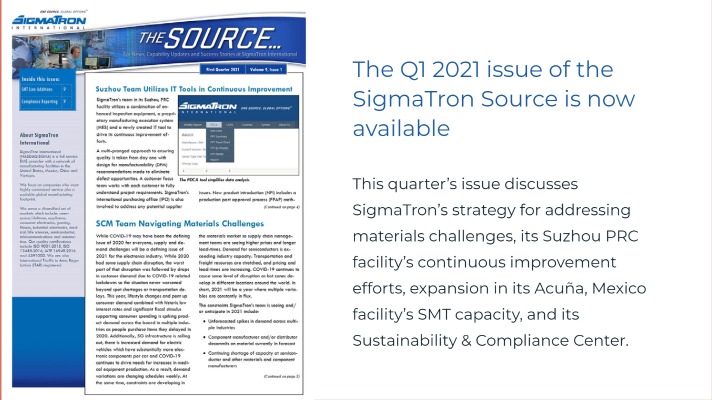
Read the full issue here.

Read the full issue here.

This continuing blog series looks at specific projects completed by SigmaTron International’s Tijuana, Mexico Six Sigma Green Belt and Yellow Belt teams. This post looks at how the team improved production throughput for a customer whose project volumes were growing rapidly. Mitzi Rodriguez and Victor Rodriguez were the project leaders.
The Green Belt teams use a DMAIC (Define, Measure, Analyze, Improve, Control) methodology to identify each improvement opportunity and strategize the appropriate solution. They were mentored in their continuous improvement projects by their facility’s Yellow Belts.
In the Define phase, teams develop a problem statement, identify critical to quality (CTQ) and defect metrics, create project objectives, determine the business case and financial impact of the desired improvement, determine customer impact/voice of the customer (VOC), set milestones and a timeline, define the project scope and boundaries, and assign team responsibilities. In the Measure phase, the teams measure the variances they associate with the problem they have identified, utilizing core tools such as Pareto and SIPOC diagrams, capability analysis to assess the ability of a process to meet specifications and Gage R&R measurements. In the Analyze phase, the teams analyze the data they’ve collected to determine trends and possible corrective actions using hypothesis tests, cause and effect, and IPO charts to test and verify which process variables are most important in influencing process outcomes. In the Improve phase, the teams implement improvements and then utilize design of experiments (DoEs) to determine if the proposed solutions are correcting problem. In the Control phase, measures to ensure continued achievement of desired metrics are implemented.
The goal was to better balance production work cells while improving revenue generated per employee. During the measurement phase, the entire production process was mapped to determine areas of processing inefficiency. It was determined that production flow through the factory was inefficient and that the hot bar process represented a bottleneck, in part due to machine-related inefficiencies in temperature measurement. Additionally, the travel distance of assemblies among processing workstations was also inefficient. The process flow was redesigned to minimize the transport distance among work areas and to improve the layout efficiency of process lines and workstations. In particular, the work cell for hot bar soldering was set up in a u-shape and all subsequent secondary operations were set up in a five-person line. The overall travel distance through the secondary assembly process shortened significantly. A thermometer with optimal resolution and fast hold trigger was added to the hot bar stations to enable operators to monitor and maintain temperature limits plus keep SPC records.
The result eliminated the bottleneck and exceeded the original 25 percent improvement in productivity.